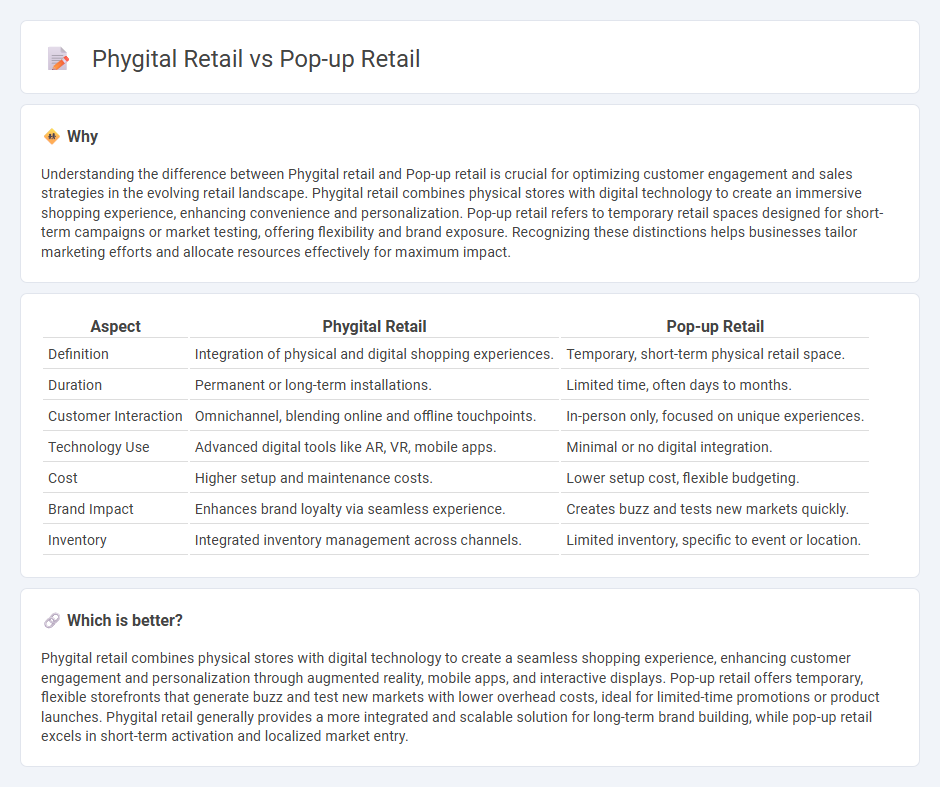
Phygital retail seamlessly combines physical stores with digital technology to enhance customer experience, driving engagement through augmented reality, interactive displays, and mobile apps. Pop-up retail offers temporary, experiential shopping spaces that create urgency and exclusivity, often used for brand testing and targeted marketing campaigns. Explore how integrating these strategies can maximize retail impact and customer satisfaction.
Why it is important
Understanding the difference between Phygital retail and Pop-up retail is crucial for optimizing customer engagement and sales strategies in the evolving retail landscape. Phygital retail combines physical stores with digital technology to create an immersive shopping experience, enhancing convenience and personalization. Pop-up retail refers to temporary retail spaces designed for short-term campaigns or market testing, offering flexibility and brand exposure. Recognizing these distinctions helps businesses tailor marketing efforts and allocate resources effectively for maximum impact.
Comparison Table
| Aspect | Phygital Retail | Pop-up Retail |
|---|---|---|
| Definition | Integration of physical and digital shopping experiences. | Temporary, short-term physical retail space. |
| Duration | Permanent or long-term installations. | Limited time, often days to months. |
| Customer Interaction | Omnichannel, blending online and offline touchpoints. | In-person only, focused on unique experiences. |
| Technology Use | Advanced digital tools like AR, VR, mobile apps. | Minimal or no digital integration. |
| Cost | Higher setup and maintenance costs. | Lower setup cost, flexible budgeting. |
| Brand Impact | Enhances brand loyalty via seamless experience. | Creates buzz and tests new markets quickly. |
| Inventory | Integrated inventory management across channels. | Limited inventory, specific to event or location. |
Which is better?
Phygital retail combines physical stores with digital technology to create a seamless shopping experience, enhancing customer engagement and personalization through augmented reality, mobile apps, and interactive displays. Pop-up retail offers temporary, flexible storefronts that generate buzz and test new markets with lower overhead costs, ideal for limited-time promotions or product launches. Phygital retail generally provides a more integrated and scalable solution for long-term brand building, while pop-up retail excels in short-term activation and localized market entry.
Connection
Phygital retail integrates physical and digital shopping experiences, enhancing customer engagement through interactive technologies in-store. Pop-up retail serves as a strategic platform within phygital retail by offering temporary, immersive spaces that blend digital interactivity with physical product exploration. This synergy leverages data-driven personalization and real-time customer feedback to optimize marketing and sales strategies in dynamic retail environments.
Key Terms
Temporary Storefronts (Pop-up Retail)
Pop-up retail leverages temporary storefronts to create immersive, short-term shopping experiences that drive immediate consumer engagement and test market responsiveness. Phygital retail integrates physical and digital elements, using technology to enhance customer interaction and streamline the buying process within both temporary and permanent spaces. Explore how these innovative retail strategies transform consumer behavior and retail performance.
Omnichannel Integration (Phygital Retail)
Phygital retail seamlessly integrates physical and digital channels to create an immersive omnichannel shopping experience, leveraging technologies such as augmented reality, mobile apps, and in-store IoT devices to engage customers. Pop-up retail offers temporary physical locations that drive brand awareness and urgency but typically lacks the deep digital integration found in phygital strategies. Explore how omnichannel integration in phygital retail transforms customer engagement and boosts sales.
Experiential Shopping
Pop-up retail offers limited-time, physical shopping experiences that create urgency and exclusivity, while phygital retail integrates digital technology with in-store elements to enhance consumer interaction and personalization. Experiential shopping in pop-up stores emphasizes sensory engagement and brand storytelling through immersive environments, contrasting with phygital retail's use of augmented reality, smart mirrors, and interactive displays to deepen customer involvement. Explore the evolving landscape of retail innovation and how these strategies transform consumer behavior by diving deeper into experiential shopping trends.
Source and External Links
What Is Pop-Up Retail? - StoreForce - Pop-up retail refers to short-term sales spaces designed to create unique customer experiences, often temporary from days to months, used to generate excitement, test markets, or offer exclusive products in flexible locations like vacant storefronts or events.
Pop-up retail - Wikipedia - Pop-up retail is a temporary retail space trend that creates unique, engaging environments for customers, often used by companies for marketing, testing products or locations, seasonal sales, or to build brand interest with low startup costs.
What is a pop-up shop? Benefits, types, and how to start - Printify - A pop-up shop is a temporary retail experience, held in physical or online venues, that helps brands generate buzz and test markets flexibly and cost-effectively, often creating exclusive, immersive shopping events without the expenses of permanent stores.
 dowidth.com
dowidth.com